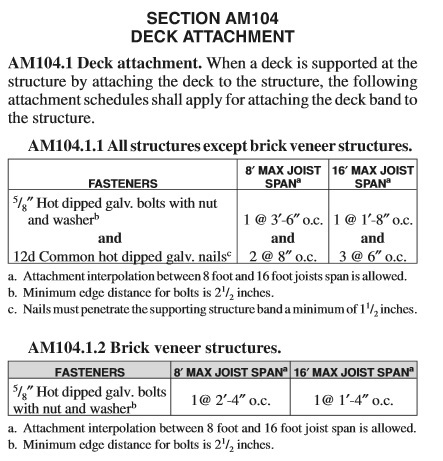grogannc
Structural
- Jan 21, 2014
- 63
I have a client that wants to have a deck structure attached to the existing home through masonry veneer. Our actually specifies a bolting spacing through masonry veneer but as others have said, I am worried about putting any load through the veneer. I found this solution from a post in 2007 but was hoping someone could help me understand the concept a little better?
"For a brick veneer the deck has to be either free standing or it should be attach to the structure using wood or steel spacers at each of the through bolt locations. A 4x or tube steel spacer the depth of the veneer plus the cavity depth and plus 1/4" x 9" or 11" long is placed at each through bolt location (typically 24" o.c.). The ledger is solidly bolted to structure with two or three bolts through the ledger and spacer and band board. The brick veneer goes on past behind the ledger and is not loaded in any way. Its best if the predrilled spacers are temporarily held in place to the band with a couple of bolts while the mason does his work then the deck contractor can drill the ledger from the back side through the band to align with the spacer holes. There needs to be through wall flashing at each spacer location. Its good if the top of the ledger aligns with a mortar joint so the spacers are easy to flash."
Wouldn't the tube steel or wood have to be closer to 4" in actual depth, ie. a nominal 4x wouldn't work. Would have to rip a 6x to size. Or am I understanding this detail? This "deck" is going to have travertine tile so a lot of DL will be going into these connections, ie. no way I would just bolt through the veneer.
"For a brick veneer the deck has to be either free standing or it should be attach to the structure using wood or steel spacers at each of the through bolt locations. A 4x or tube steel spacer the depth of the veneer plus the cavity depth and plus 1/4" x 9" or 11" long is placed at each through bolt location (typically 24" o.c.). The ledger is solidly bolted to structure with two or three bolts through the ledger and spacer and band board. The brick veneer goes on past behind the ledger and is not loaded in any way. Its best if the predrilled spacers are temporarily held in place to the band with a couple of bolts while the mason does his work then the deck contractor can drill the ledger from the back side through the band to align with the spacer holes. There needs to be through wall flashing at each spacer location. Its good if the top of the ledger aligns with a mortar joint so the spacers are easy to flash."
Wouldn't the tube steel or wood have to be closer to 4" in actual depth, ie. a nominal 4x wouldn't work. Would have to rip a 6x to size. Or am I understanding this detail? This "deck" is going to have travertine tile so a lot of DL will be going into these connections, ie. no way I would just bolt through the veneer.

